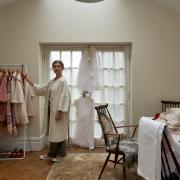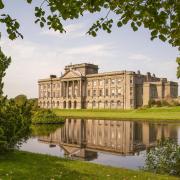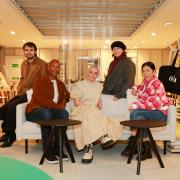In a county boasting more than 40 Grade I listed churches, the task of featuring just 21 is not without its difficulties. The listed churches in the county range from the grandeur, elegance and sheer beauty of Saint Mary and All Saints at Great Budworth, or the parish church of Saint Mary at Nantwich, to the relative simplicity and understated dignity of Saint Peter at Aston-by-Sutton or Saint Helen at Northwich.
A number of different styles of architecture can be seen in the listed churches featured, with many dating from the Norman period or earlier.
During the 12th century, the Norman style of church architecture was gradually replaced by the Gothic style, which had its origins in northwest France. English Gothic architecture flourished between about 1180 and 1520. The three predominant styles were: Early English Gothic, which dated from, about, 1180 to 1250; Decorated Gothic which was fashionable between 1250 and 1350; and Perpendicular Gothic from 1350 to 1520. Early English Gothic is characterised by pointed arches or lancets. In addition to using pointed arches in wide-span arches such as the nave arcade, lancet design was used for doors and, more often, stained glass windows. Decorated Gothic is distinguished above all by the tracery on the stained glass windows. Design innovations enabled increasingly elaborate windows to appear, separated by narrowly spaced parallel mullions. Perpendicular Gothic has a predominance of vertical lines, most noticeable in the stone tracery of the windows. This is demonstrated to its best effect in the design of enlarged windows, utilising slimmer stone mullions than was possible in earlier periods, giving greater flexibility for stained glass craftsmen.
Nationwide difficulties, such as the English Civil War, the Reformation or the bubonic plague, which took place during building, meant many of the churches described incorporate a number of different architectural styles, indicating that the building took many years to evolve and complete. Similarly, it was not unheard of for a church benefactor to have the church rebuilt or substantially modified to conform to contemporary ecclesiastical fashion or personal cupidity.

Saint Bertoline’s, Barthomley
The oldest part of Saint Bertoline’s, Barthomley, a predominantly Perpendicular style church, is a Norman blocked doorway, situated in the north wall in a space between the end of the aisle and the vestry. But, it is the massacre at the church that gives an indication of the role played by parish churches in the social and economic history of the country. The church was the scene of one of the most horrendous and notorious incidents in the history of the Civil War. Although the Parliamentarians controlled much of the county of Cheshire, the Royalists, having been strengthened by a contingent arriving from Ireland towards the end of 1643, decided to seize the initiative and actively seek locations where the Parliamentarians held sway. Two days before Christmas, on December 23, 1643, Royalist troops marched on the village of Barthomley.
The contemporaneous account of the confrontation states that some 20 ‘neighbours’ sought refuge in the church, but that the Royalist pursued them into the church, forcing the ‘neighbours’ to climb into the church steeple. The marauding troops then set a fire, burning 'formes, pewes, Rushes & the lyke', whereupon, the besieged neighbours 'called for quarter, & yelde theim selves'. The troops’ commander, Major Connaught, having secured ascendency, then decided against granting the amnesty – perhaps, as is recorded in some accounts, because of the fact that the rector’s son, John Fowler, fired on the soldiers, killing one of them, and provoking Connaught’s reaction. 'Hee caused theim all to be stripped starke Naked; And moste barbarouslie & contr[ar]y to the Lawes of Armes, murthered, stabbed and cutt the Throates of xii of theim;...& wounded all the reste, leavinge many of theim for Dead.'
Some 11 years later, Connaught was tried at Chester assizes for the murder of ‘several persons’, although much of the trial focused on the killing of John Fowler. Having been found guilty, Connaught was hanged at Boughton on the outskirts of Chester. (Location: CW2 5PF)

Saint Peter’s, Plemstall
The recorded history of Saint Peter’s, Plemstall, can be traced back to the seventh century. It is thought the present church was built on the site where Plegmund, a ninth-century hermit, once lived. The church stands in a raised area, formerly known as 'The Isle of Chester'. Close to Saint Peter's is a well named after Plegmund, who became Archbishop of Canterbury in 890 under Alfred the Great. Prior to this, people who visited his cell were baptised by Plegmund at the well. Many years before Plegmund, the well is thought to have been used by Druids.
The church has a rare three-decker pulpit located in the north aisle, and an adjacent two-decker reader’s desk which is dated 1722. The seven-foot high churchwarden’s pew dates from 1697.
In 1945, the church was presented with five bibles by the historian Raymond Richards; these include a folio edition of the bible printed by Edward Whitchurche in 1549, a black letter bible also of 1549, a 'Breeches' Bible dated 1608 and two King James Bibles, one dated 1611 and the other dated 1623.
The large Hurleston family vault, which is outside of the church at the east end, has on the long south- and north-facing sides of the tomb-chest recumbent skeletons, one, apparently, male, and the other, apparently, female. (Location: CH2 4EW)

Saint Helen's, Northwich
The church of Saint Helen, Northwich, was initially built in the vicinity known as Witton as a chapel of ease for the church of Saint Mary and All Saints at Great Budworth. The chapel of ease had similar dimensions to the present building, although there were no aisles, chapels or clerestory. The chapel did not have pews as such, but stone benches strategically placed around the walls for the comfort of parishioners. Then, with increases in population and church attendance, as was the case with so many churches at that time, north and south aisles were added.
During the period of the Reformation and the Civil Wars, the church lost many of its stained glass windows and medieval monuments. Fortunately, between 1863 and 1910, leading stained glass designers, including William Wailes, Charles Alexander Gibbs and the celebrated Victorian designer Charles Eamer Kempe, were commissioned to design and install new windows which now adorn the church. Then, in 2000, the Millennium Window was designed by pupils from Witton Church Walk C of E Nursery and Primary School. (Location: CW9 5PB)

Saint Wilfrid's, Grappenhall
The church of Saint Wilfrid, Grappenhall, follows a traditional plan, having a continuous nave and chancel of seven bays with a clerestory together with north and south aisles. The red sandstone from which the church was built was quarried at Cobb’s quarry. There is a chapel at the east end of the south aisle, a vestry and a south porch, and a three-stage tower with a Tudor west door. The chancel east window follows the Perpendicular style. On the wall of the south aisle, the remnant of a Norman corbel table is decorated with carved human heads.
When the hamlet of Grappenhall was mentioned in the Domesday Book of 1086, there were only six adult male inhabitants. The first church on the site was, in all probability, built in the early part of the 12th century. This was verified during the church restoration of 1873/1874 when the earlier foundations were uncovered directly under the present nave and chancel.
There is a plaque inside the church that gives a continuous record of all the rectors of Grappenhall, starting with Robert of Gropenhale, who witnessed the charter in 1189.
When Saint Wilfrid's was being restored in the late 19th century, the Norman font, one of the treasured artefacts of the church, was rediscovered. The font had been buried during the Reformation in order to save it from destruction.
Just below the west window on the outside of the church, there is a relief sculpture of a Cheshire Cat. It is believed by many that this was the inspiration for the cat in Lewis Carroll’s stories – his father being the vicar of the nearby church at Daresbury. (Location: WA4 3EP)

Saint Mary and All Saints', Great Budworth
It is recorded that there was a priest in Great Budworth at the time of the Domesday survey, but there is no reference made to there being a church in the locality. However, in 1130, William Fitz Nigel, Constable of Chester and Baron of Halton, granted permission for the Augustinian canons from the nearby Norton Priory at Runcorn to build a church in the area. The church of Saint Mary and All Saints, Great Budworth was constructed of warm red sandstone and built during the 14th century. It is predominantly Perpendicular in style, although the north transept follows the Decorated style of architecture. There is a six-bay nave with a clerestory and a chancel flanked by chapels to the north and south: the north transept, which follows the Decorated Gothic style of architecture, is the Lady Chapel and is the oldest part of the church, dating from the 14th century. The south transept is known as the Warburton Chapel.
There are five,13th-century oak stalls in the Warburton Chapel, together with a number of the original plain misericords. There is also a stone altar in the chapel which, originally, was to be found in the chancel. At the time of the Reformation, the stone was removed for safekeeping and was used as a flooring slab. When the altar was rediscovered in the 19th century, it was placed in the Warburton Chapel. During the Reformation years of the 16th century all involvement with the priory ceased, and the previously highly decorated church, which the Augustinian canons had created, became little more than a white-washed preaching hall. Puritan ministers then set about converting the people of the parish from a tradition of religious conservatism to a form of radical Protestantism. Ultimately, however, parishioners mellowed and accepted the broader Anglican Church traditions. Rowland E Egerton-Warburton of Arley Hall funded much of the church restoration during the 19th century and encouraged the return of a more Anglo-Catholic style of worship.
There is a large medieval oak chest in the church which has four locks. The four different keys to the locks were held by church officials, and the chest could only be opened when all four keys were used.
The prolific Victorian designer Charles Eamer Kempe designed the stained glass in the east window and also the east windows of both aisles. The French stained glass designer Francois Pierre Fourmaintraux designed the Expressionist glass in the north transept. (Location: CW9 6HF)

Saint Oswald’s, Lower Peover
It was in 1269 that Richard Grosvenor of Hulme Hall founded Saint Oswald’s Church, Lower Peover, as a chapel of ease, thus saving the long journey to the mother church of Saint Mary and All Saints’ church at Great Budworth. When the church was first built, the priest from Great Budworth officiated at services, as there was no regular priest at Saint Oswald’s. The first resident priest was installed during the 15th century and lived where the Bells of Peover pub now stands. The original timber-framed church would have had wattle and daub walls and a thatched roof, and worshipers would have stood or sat on the floor during the services, with older parishioners leaning against the walls for support. This tradition gave rise to the expression, the weakest go to the wall'.
Located in the Shakerley Chapel in the south aisle is Saint Oswald’s famous 'bog-oak, dug-out chest’, made from a single log, measuring six feet long by two feet wide. The chest was used for many years to keep parish registers, vicars’ robes, chalices and other church documents. Before any service could commence, however, the four churchwardens and the minister had to be present so all of the five locks, four of which had been added at the time of the Reformation, could be opened. For many generations, there was a belief in the parish that if a maiden wished to marry a farmer she had to be able to lift the chest lid with one arm. It is thought this view emerged as, in medieval times, farmers' wives had to be strong enough to be able to lift one of the very heavy rounds of Cheshire cheese, which were made in most of the district’s farms.
There are two bread shelves near to the font. From these shelves, loaves of bread were distributed to the poor within the parish in accordance with a bequest made by Richard Comberbach and his wife. (Location: WA16 9PY)

Saint Mary's Nether Alderley
Alderley is referred to as ‘Aldredeli’ in the Domesday Book, but, by 1327 it was known as ‘Alderlegh’. The church of Saint Mary, Nether Alderley, dates from the early part of the 14th century, although it is probable that there was an earlier timber-framed church on the site before that time. The church was originally dedicated to Saint Lawrence, but the dedication was later changed to Saint Mary.
For many years, the Stanley family of Alderley has had associations with the church; there is a Stanley mausoleum in the church grounds and at the eastern end of the south aisle is the 17th-century Stanley pew: the pew is at the level of an upper storey and can only be entered from a flight of steps which are on the outside the church. There are also several monuments to the Lords Stanley of Alderley.
In 1598, a bitter feud erupted between two of the leading families in the region – the Stanleys of Alderley and the Fittons of nearby Gawsworth. The dispute related to space within the church, when members of the Stanley family claimed their chapel was ‘cut down’ during the night of February 24, the Feast of St Matthias the Apostle. The dispute became so intense the Stanley family suggested Sir Edward Fitton truly deserved his reputation as the Fighting Fitton. The protracted dispute was finally resolved when the Fitton family agreed to use the ground floor of the church, and the Stanley family agreed to use the upper floor; hence the Stanley pew being at the level of an upper storey.
In 1830, bodysnatchers stole the corpses of two women from the churchyard. The perpetrators of the deed were duly apprehended, but, as the statute book made no reference to body snatching, no crime had been committed. Justice, of sorts, was ultimately served, however, when the bodysnatchers were charged with stealing the wedding rings from the bodies. They were given prison sentences. (Location: SK10 4TW)

Saint John the Baptist, Chester
The Anglo-Saxon church of Saint John the Baptist, Chester, was, traditionally, founded by King Aethelred of Mercia in 689. The church was extended in the 10th century by the Earl of Mercia whose wife, Aethelflaeda, was the daughter of Alfred the Great. The foundation of the present church is credited to Bishop Peter de Lea, who moved the See from Lichfield to Chester in 1075. Saint John’s became the cathedral church and continued as Chester’s cathedral until 1082 when Bishop Peter died. He was succeeded by Robert de Limesey who immediately transferred the See to Coventry. Following the Dissolution of the Monasteries in the 16th century, Chester Abbey assumed the status of Chester Cathedral, thus relegating the church of Saint John the Baptist to that of a parish church.
During the Civil War, the Royalists held the city for Charles I. However, at the time of the siege of Chester in 1645, Roundhead troops used the church as a garrison and gun platform from which they were able to bombard the city and its walls.
Built by William Hill and Company of London as a temporary piece for the coronation of Queen Victoria in 1838, the organ was rebuilt after the coronation. It was then transported by barge from Westminster Abbey to Chester where it was installed in the west end of Saint John’s. To celebrate the occasion, the inaugural recital was given by Henry Gauntlett on October 28, 1838. Charles Whiteley and Company converted the organ to an electro-pneumatic action in the 1960s. Because of vandalism, further restoration became necessary in 2002.
In 1901, the master builders of Chester placed a memorial window, by Shrigley and Scott, in the northeast nave aisle. The window commemorated the architect Thomas Meakin Lockwood and depicted Hiram, builder of the Temple at Jerusalem. (Location: CH1 1SN)

Saint Peter, Aston-by-Sutton
In 1236 Sir Thomas de Dutton built the first religious building in the hamlet of Aston-by-Sutton, a chapel of ease which was known as the Chapel of Poosey (or Pooseye). It was not until the latter part of the 13th century that the bishop of Lichfield ordered that a chaplain, together with a lamp, should be provided by the prior of Norton Priory. When a domestic chapel was added at Dutton Hall, Poosey Chapel fell into disrepair.
Originally the church had 13 pews on either side of the nave with a further 10 pews in the gallery. Of these, six pews were ‘free’ and of the other four pews, one was allotted to Aston Hall men servants, one to Aston Hall maid servants and two pews were allotted to the choir. The six pews under the gallery were ‘free’, but all of the pews in the nave were allotted to specific families, with one pew being specifically allocated to the Aston Hall upper servants.
Saint Peter, Aston-by-Sutton, has but one bell, but there is a very interesting story behind it. According to church records, there was a vestry meeting in 1872 when: 'The Minister and Wardens consented to the old bell belonging to the church being removed to the new Aston School and the bell presented by James Campbell Esquire being fixed in the Church.' In fact, the bell presented by James Campbell bore the inscription 'Crescent City 1870', and came from the ill-fated Crescent City, a new ship owned by the Liverpool and Mississippi Steamship Company, which had foundered on her return maiden voyage from New Orleans to Liverpool after encountering tumultuous gales and fog. The ship had been specially built at McMillan’s yard in Dumbarton for the New Orleans-to-Liverpool trade with its name taken from the old name of New Orleans, which was Crescent City. During the latter part of the fateful voyage, the ship’s master misread his sextant, which resulted in the ship being wrecked on Dhuilig rock in Rosscarbery Bay on the south coast of Ireland.
(Location: WA7 3ED)

Saint Mary's, Nantwich
The church of Saint Mary's, Nantwich, is often described as the ‘Cathedral of South Cheshire’. Originally, there was a chapel of ease on the site, which was in the parish of Acton. At the beginning of the 12th century, the church at Acton and the chapel at Nantwich both came under the direct control of the Cistercian abbey of Combermere.
Building started on the present church at Nantwich in the mid-14th century and followed the contemporary Decorated style of the period, employing Yorkshire masons for the workforce, and using local Eddisbury sandstone as the primary building material. For the first nine years building progressed at a satisfactory pace, but then, in 1349, work was halted due to an outbreak of the black death in the area. Building work resumed towards the end of the century when the town had recovered its economic prosperity. By this time however, there was a different workforce and a different architectural style being adopted. The masons were brought from Lichfield and Gloucester cathedrals and construction now followed the Perpendicular style of architecture.
There was a period during the Civil War when the church was used as a prison for Royalist troops who had been captured at the battles of Nantwich and Preston.
Built in a typical cruciform in shape, the church has a four-bay nave with north and south aisles, a three-bay chancel, to the north of which is a two-storey treasury, a south porch with two storeys, north and south transepts and an unusual central tower, which is square at its base and octagonal above.
There are carved wooden canopies over the choir stalls and 20 misericords at the back of the stalls. The misericords – 10 on the north side of the chancel and 10 on the south side – are reputed to be among the finest in the country, with the exquisitely carved subjects ranging from a devil pulling a woman's mouth open as punishment for lying, to a man taking a cock to a cockfight. There are also more traditional carved symbols, such as Saint George battling a dragon. One of the more famous carvings depicts the face of a priest on the rear of a bird. It is considered by many that this carving gives rise to the expression ‘the parson’s nose', when talking of the rump of a roast chicken.
Two of the many historical artefacts to be found in the transept at Saint Mary’s are a bench that dates from 1737 and a large bread chest, or dole chest as it is sometimes referred to. The chest dates from 1676 and, in former times, was used to store bread, which was distributed after Sunday services to poor people living in the parish.
The magnificent Jubilee curtains, made by the church’s tapestry group, are to be found along the west wall at the back of the church and commemorate the silver jubilee of the late Queen Elizabeth II in 1977. (Location: CW5 5RQ)
David Paul was born and brought up in Liverpool. Since retiring, the former marine engineer, lecturer, head of the engineering department at North Manchester College and principal of Castle College in Sheffield, has written a number of books on different aspects of the history of Cheshire, Derbyshire, Lancashire, Yorkshire, Shropshire and Liverpool.
Churches of Cheshire is available at all good local bookshops and retailers or direct from Amberley Publishing at amberley-books.com/churches-of-cheshire.html




























